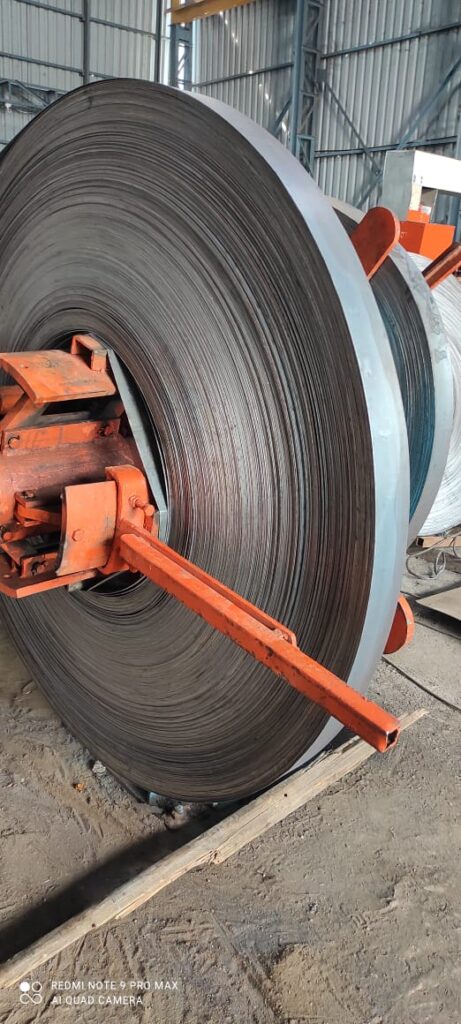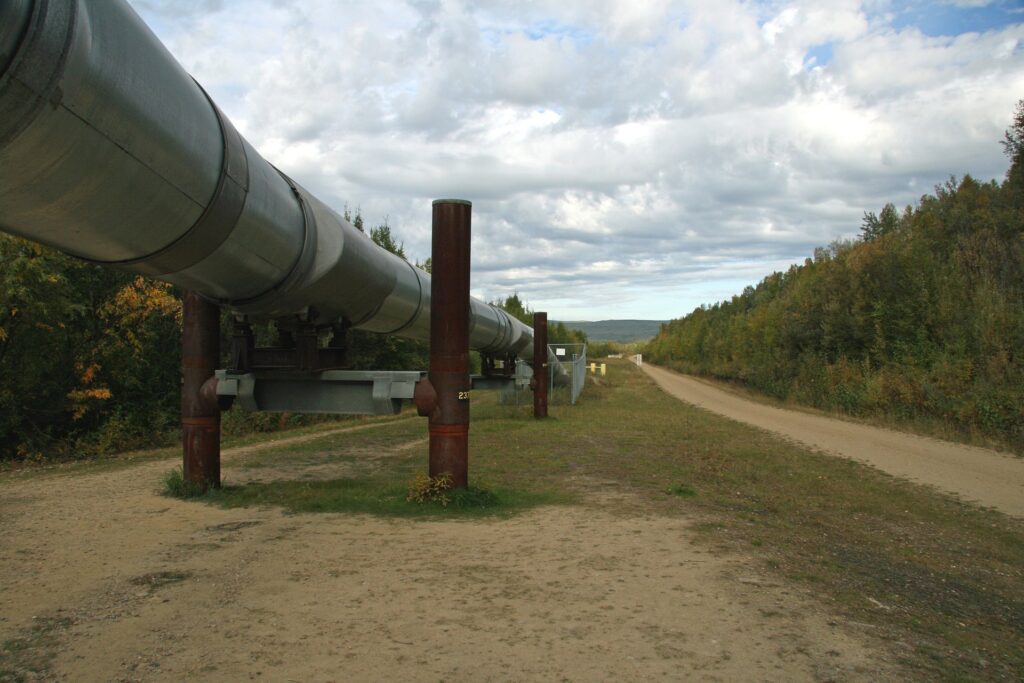Welded steel pipes are a class of pipes manufactured by rolling steel sheets or plates and then welding their edges. The pipes are very popular in the manufacturing industry because their production process is relatively simple and inexpensive. Welded pipes can be further divided into two main categories: longitudinally welded pipes and spiral welded pipes.
Longitudinally welded pipes are fabricated by bending the steel sheets to the desired configuration and welding the longitudinal seam. The longitudinally welded pipes are more accurate and stronger, due to which they find wide applications in the oil and gas industry, water supply systems, and structural purposes.
Spiral welded pipes, on the other hand, are made in a process where steel sheets are welded into a spiral shape. They cater to pipelines carrying much wider diameters, such as large water distribution systems and sewage pipelines.
The manufacturing process for welded steel pipes involves the use of electric resistance welding (ERW) and submerged arc welding (SAW) techniques. They find wide applications in infrastructure developments, automotive industries, and construction projects. Their availability and cost-effectiveness have made these pipes an affordable and reliable choice for industries and projects.
What Are Welded Steel Pipes?
Welded steel pipes are those made by welding together steel plates or strips. They have relatively simple manufacture, due to which they are inexpensive and thus very common. First, the steel sheet is rolled into a cylindrical shape and then its edges are welded. This welding process may be longitudinal, that is, straight line, or helical—spiral—based on the pipe’s size and area of application.
WELDED STEEL PIPES are in wide use in oil and gas transportation, water supply systems, structural applications, and construction projects. Their main advantage is the possibility of producing large sizes and custom thicknesses to fit various industries.
The outer surface of these pipes is smooth and even, though their strength is somewhat lesser in comparison with the seamless ones due to the welding seam. That is why the application of such welded pipes is limited under high-pressure and extreme conditions.
The two major types of welding processes used are electric resistance welding (ERW) and submerged arc welding (SAW). ERW pipe is mostly used in lightweight and low-pressure applications, while SAW pipes are used in heavy-duty and high-pressure systems.
Manufacturing Process of Welded Steel Pipes
Preparation of Raw Materials
The initial step in the process of manufacturing welded steel pipes includes the selection and preparation of raw materials, which are usually steel plates or hot-rolled steel coils. The raw materials are sheared to the required dimension, followed by the pickling or surface treatment operations that remove oxide compounds. Surface treatment is very essential because it assures a smooth and continuous process of welding with no defects.

Forming Process
The steel sheet or strip is rolled into a cylindrical shape. The shaping process takes place in special forming machines. Depending on the type of pipe and application, the forming process can be either longitudinal or spiral (helical). Longitudinal pipes are made with straight seams while spiral pipes can be suitable when more flexibility in diameter is needed.
Welding
The edges of the steel sheet are, therefore, welded by using some special welding techniques like Electric Resistance Welding—ERW (for the thin-walled and low-pressure pipes) and Submerged Arc Welding—SAW only for the thick-walled as well as the heavy-duty welded pipes. Again after welding is completed, inspecting the weld seams would identify possible defects; these could be adjusted and re–welded again if necessary
Sizing and Straightening
The sizing rollers and straightening machines bring the pipe to its exact size and shape after welding. This ensures that the diameter, thickness, and straightness of the pipe are within the required standards.
Heat Treatment and Inspection
The heat treatment either annealing or normalizing of the pipe is done so that the welded pipe has enough stress relief and strength. Subsequently, NDT processes like ultrasonic testing, X-ray inspection, and hydrostatic pressure testing of the pipes shall be carried out to ensure the pipes are leakage-free and defects-free.
Surface Coating and Final Touches
During the final stage of production, surface coating is applied to the pipes. This is to increase the pipe’s resistance to corrosion. The pipes may be treated with galvanizing, painting, or epoxy coating. Lastly, after the final inspection and packing, the pipes are ready for shipment.

Types of Welded Steel Pipes
Electric Resistance Welded (ERW) Pipes:
ERW pipes are manufactured by rolling steel coils or plates into a cylindrical shape, and their edges are welded by heating them using electric resistance. The process has a much higher efficiency and is more cost-effective. Both the outer and inner surfaces of ERW pipes are smooth, making them perfect for low-pressure applications like water pipelines, fencing, scaffolding, and furniture. The pipes are lightweight with uniform thickness, which makes transportation and handling easier. But, they are not used for high-pressure and severe conditions as the welding seam creates a weak point.
Submerged Arc Welded (SAW) Pipes:
SAW pipes are manufactured to use in heavy-duty and high-pressure applications. This process is initiated by rolling of steel plates into pipe and is followed by the submerged arc welding technique that guarantee the strong and reliable welds. SAW pipes are available in two forms Longitudinal SAW – LSAW and Spiral SAW- HSAW/ SAW. LSAW pipes have a straight weld seam and are intended for oil and gas pipelines, structural applications, and large-scale projects. HSAW pipes are spiral welded and are flexible; hence, they are economical.
Spiral Welded Pipes:
These pipes are manufactured by the rolling and welding of steel coils into a spiral shape. They are used in large-diameter pipelines for transporting water, among others, and in irrigation projects. Spiral welded pipes are cost-efficient, customizable, but are little used in critical high-pressure applications because of the reliability of the seams.
Applications of Welded Steel Pipes
Oil and Gas Industry:
Welded steel pipes find great applications in the oil and gas industry. Their use is mainly in exploration, processing, and transportation for both oil and natural gas. They serve in pipeline networks of offshore as well as onshore plants. In long-distance pipelines, large diameter pipes are used. The ERW pipes are applied in low-pressure oil and gas transmission systems.
Water Supply and Sewage Systems:

Welded steel pipes have very good water and waste water conveyance management. They are in municipal water supply systems because of the huge volumes that they convey with high efficiency. They also find applications in sewage and drainage systems where durability and resistance to corrosion are essential.
Construction and Structural Applications:
Welded pipes are widely used as construction elements in the construction industry. Pipelines are used to build bridges, buildings, and industrial sheds. Their light-weighted but strong nature makes them perfect for construction purposes.

Agricultural and Irrigation Systems:
Welded steel pipes – These are used in agricultural and irrigation systems. They are designed to carry water over great expanses efficiently. They are predominantly used by farmers in drip irrigation and sprinkler systems for easy water management.
HVAC
Welded steel pipes are used in HVAC systems for transportation of air and fluids. The smooth inner surface provides the needed efficiency in the flow, and their lightweight material makes them easy to install. They are quite common in residential and commercial HVAC applications.
Advantages of Welded Steel Pipes
Cost-Effective Manufacturing: The manufacturing cost of the welded steel pipes is much lower than that of seamless pipes. The process of welding steel plates or strips is quite simple and highly effective. Welded pipes are cost-effective for mass production and present an inexpensive solution for industries.
Customization and Versatility: Welded steel pipes come in different sizes and thicknesses and hence may be tailor-made for various applications. Spiral welded pipes are greatly suitable, especially due to their large diameter, for water pipelines and structural support projects, while the smaller diameter pipes are mainly used in fluid and gas transportation.
Easy Availability and Fast Production: The production speed of welded pipes is much higher than that of seamless pipes, hence helping to efficiently meet the demand. Their raw material and manufacturing facilities are easily available in every region, hence making the supply chain seamless.
Challenges of Welded Steel Pipes
Reduced Strength: Such pipes are relatively weaker as compared to seamless pipes because of the welding seam. When under stress and pressure, welded joints can develop weak points; hence, they are not useful for high-pressure applications.
Corrosion Vulnerability: The welded area is more vulnerable to corrosion, which can influence the life and functionality of the pipe. Unless properly coated and maintained, the life expectancy of the welded pipes can be lowered.
Limited High-Pressure Applications: Welded pipes are hazardous in high-pressure and hostile environments. Seamless pipes are required for critical environments, like oil refineries and power plants, more than such pipes cannot be used at those places.
Variation in Quality: The quality of the welding process will determine the performance of the pipe. Poor welding implies greater risks related to leakage and failure. This needs the presence of skilled workforce and quality control, which all manufacturing units may not possess.
Tips for Maintaining Welded Steel Pipes
Regular Inspection: The welded steel pipes should be checked periodically in order to ascertain their durability and performance. The outside surface, weld seams, and inside linings of the pipes should be observed visually every quarter of a year. Damages like corrosion, dents, or cracks might be detected in advance so that urgent repair may be done on the necessary aspects. Leakage or weakness must be repaired at once.
Proper Cleaning: Pipe maintenance begins with keeping the pipes clean. The pipes should be cleared of dirt, debris, and corrosive substances from time to time. In the case of chemical pipelines, it’s better to go for anti-corrosion cleaning solutions. In the case of pipes used in water or liquid transportation, deposits and residues can be removed by the use of flushing techniques.
Preventive Coating and Protection: It should have protective coatings done by painting. These Welded steel pipes also depend on types, therefore epoxy coating, or even Galvanization Techniques extends the life. If Pipes are in the Open Environment, it needs protecting against moisture or some extreme climate.
Monitoring of the Pipes: Excessive pressure or load on pipes may weaken their weld seams. Consequently, pressure and flow must be regularly monitored. Overloading should be avoided while proper adjustments need to be affected in case the pressure requirements change.
Timely Repairs and Replacement: If there is a minor damage or wear and tear of pipes, it should be repaired immediately. Minor damages may lead to a major failure if not promptly attended to in time. An important part of the maintenance work involves replacing damaged pipes that are in shambles.
Conclusion
Welded steel pipes are widely applied in both industrial and domestic installations due to their versatility and economy. Their manufacturing is quite simple: steel sheets or strips are rolled into a cylindrical shape and then welded together. It makes them efficient for mass production, fitting the bulk requirements of industries.
The pipes, which are welded through the process of welding, come in different sizes and thicknesses, starting from small bore up to big ones, enabling them to suit various industries: oil and gas transportation, water supply systems, structural frameworks, and construction projects. Spiral welding helps produce large-diameter pipes used in certain special applications.
They do, however, have some limitations: their strength is lower in comparison with seamless pipes, as they contain welding seams, and they are not as reliable under high-pressure and extreme-temperature conditions. In addition, their corrosion resistance may also sometimes become a problem affecting their durability.
In the final analysis, welded steel pipes do represent a balanced solution where a combination of cost and performance is required. When properly selected and maintained, such pipes could assure long service life and reliable performance.




Pingback: What is HOT ROLLING MILL? - STEEL PRODUCT INFO.
Pingback: Slitting machine Line - WISERBOLT
Pingback: SEAMLESS STEEL PIPES:- A DETAILED GUIDE